
Sidney Rigdon was a leader during the early history of the Latter Day Saint movement.
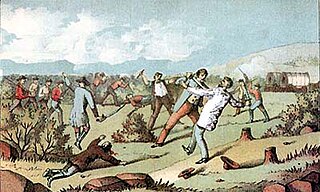
The Danites were a fraternal organization founded by Latter Day Saint members in June 1838, in the town of Far West, Caldwell County, Missouri. During their period of organization in Missouri, the Danites operated as a vigilante group and took a central role in the events of the 1838 Mormon War. They remained an important part of Mormon and non-Mormon folklore, polemics, and propaganda for the remainder of the 19th century, waning in ideological prominence after Utah gained statehood. Notwithstanding public excommunications of Danite leaders by the Church and both public and private statements from Joseph Smith referring to the band as being both evil in nature and a "secret combination", the nature and scope of the organization and the degree to which it was officially connected to the Church of Christ are not agreed between historians. Early in the group's existence, Joseph Smith appeared to endorse its actions, but later turned against it as violence increased and the actions of the Danites inspired a hysteria in Missouri that eventually led to the Extermination Order. According to an essay on the website of the Church of Jesus Christ of Latter-day Saints, "Historians generally concur that Joseph Smith approved of the Danites but that he probably was not briefed on all their plans and likely did not sanction the full range of their activities."

Missouri Executive Order 44 was a state executive order issued by Missouri Governor Lilburn Boggs on October 27, 1838, in response to the Battle of Crooked River. The clash had been triggered when a state militia unit from Ray County seized several Mormon hostages from Caldwell County, and the subsequent attempt by the Mormons to rescue them.

David Whitmer was an early leader of the Latter Day Saint Movement and one of the Three Witnesses to the gold plates of the Book of Mormon. Whitmer later distanced himself from Joseph Smith and was excommunicated from the church in 1838, but continued to affirm his testimony of the Book of Mormon. He was the most interviewed Book of Mormon witness.
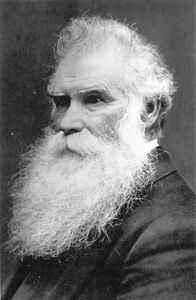
Orson Pratt Sr. was an American religious leader and mathematician who was an original member of the Quorum of the Twelve Apostles of the Church of Christ. He became a member of the Quorum of the Twelve of the Church of Jesus Christ of Latter-day Saints and was a leading Mormon theologian and writer until his death.
Thomas Baldwin Marsh was an early leader in the Latter-day Saint movement and an original member of the Quorum of the Twelve Apostles, who served as the quorum's first president in the Church of the Latter Day Saints from 1835 to 1838. He withdrew from the church in 1838, was excommunicated from it in 1839, and remained disaffected for almost 19 years. Marsh was rebaptized into the Church of Jesus Christ of Latter-day Saints in July 1857, but never again served in church leadership positions.
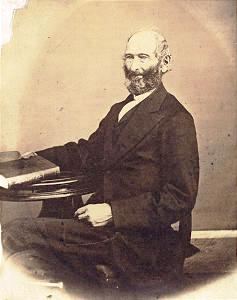
John Whitmer was an early leader in the Latter Day Saint movement. He was one of the Eight Witnesses of the Book of Mormon's golden plates. Whitmer was also the first official Church Historian and a member of the presidency of the church in Missouri from 1834 to 1838.
The succession crisis in the Latter Day Saint movement occurred after the killing of the movement's founder, Joseph Smith, on June 27, 1844.
A Rigdonite is a member of the Latter Day Saint movement who accepts Sidney Rigdon as the successor in the church presidency to the movement's founder, Joseph Smith Jr. The early history of the Rigdonite movement is shared with the history of the Latter Day Saint movement, but as of the 1844 succession crisis becomes distinct. Sidney Rigdon and other church leaders, including Brigham Young and James J. Strang, presented themselves as leaders of the movement and established rival church organizations. Rigdon's group was initially headquartered in Pittsburgh, Pennsylvania. It was known at one point as the Church of Jesus Christ of the Children of Zion, and its adherents are referred to as Rigdonites, or sometimes "Pennsylvania Latter Day Saints" or "Pennsylvania Mormons." The only surviving organization that traces its succession back to Rigdon's organizations is The Church of Jesus Christ, founded by a group of Rigdon's followers led by William Bickerton.
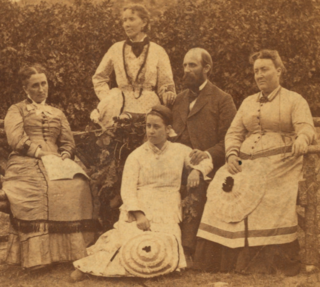
Polygamy in the Church of Jesus Christ of Latter Day Saints, or plural marriage, is generally believed to have originated with the founder of Mormonism, Joseph Smith. According to several of his associates, Smith taught that polygamy was a divine commandment and practiced it personally, by some accounts marrying more than 30 women, some of whom had existing marriages to other men. Evidence for Smith's polygamy is provided by the church's "sealing" records, affidavits, letters, journals, and diaries. However, until his death, Smith and the leading church quorums denied that he preached or practiced polygamy. Smith's son Joseph Smith III, his widow Emma Smith, and the Reorganized Church of Jesus Christ of Latter Day Saints challenged the evidence and taught that Joseph Smith had opposed polygamy. They instead claimed that Brigham Young, the head of the Church of Jesus Christ of Latter-day Saints, introduced plural marriage after Smith's death. In 1852, leaders of the Utah-based LDS Church publicly announced the doctrine of polygamy.

Signature Books is an American press specializing in subjects related to Utah, Mormonism, and Western Americana. The company was founded in 1980 by George D. Smith and Scott Kenney and is based in Salt Lake City, Utah. It is majority owned by the Smith-Pettit Foundation.

Adherents to the Latter Day Saint movement view the Book of Mormon as a work of divinely inspired scripture, which was written by ancient prophets in the ancient Americas. Most adherents believe Joseph Smith's account of translating ancient golden plates inscribed by prophets. Smith preached that the angel Moroni, a prophet in the Book of Mormon, directed him in the 1820s to a hill near his home in Palmyra, New York, where the plates were buried. An often repeated and upheld as convincing claim by adherents that the story is true is that besides Smith himself, there were at least 11 witnesses who said they saw the plates in 1829, three that claimed to also have been visited by an angel, and other witnesses who observed Smith dictating parts of the text that eventually became the Book of Mormon.
Ezra Booth was an early member in the Latter Day Saint movement who became an outspoken critic of Joseph Smith and the Church of Christ. He was "the first apostate to write publicly against the new Church". Before joining the early Church of Christ in 1831, Booth worked as a Methodist Episcopal minister and a farmer in Ohio. After his baptism, he moved with his family to Kirtland and served as a missionary, preaching in Missouri and Ohio. Booth left the church later in 1831, five months after his baptism. He proceeded to write a series of nine letters denouncing Mormonism that were published by the Ohio Star.
Richard Eyring "Rick" Turley Jr. is an American historian and genealogist. He previously served as both an Assistant Church Historian of the Church of Jesus Christ of Latter-day Saints and as managing director of the church's public affairs department.
Mark Roscoe Ashurst-McGee is an American historian of the Latter Day Saint movement and editor for the Joseph Smith Papers project.
Steven Craig Harper is a professor of church history and doctrine at Brigham Young University. He was a historian for the Church History Department of the Church of Jesus Christ of Latter-day Saints. From 2019, he is the Editor-in-Chief of BYU Studies Quarterly.
Mormon studies is the interdisciplinary academic study of the beliefs, practices, history and culture of individuals and denominations belonging to the Latter Day Saint movement, a religious movement associated with the Book of Mormon, though not all churches and members of the Latter Day Saint movement identify with the terms Mormon or Mormonism. Denominations of the Latter Day Saint movement include the Church of Jesus Christ of Latter-day Saints, by far the largest, as well as the Community of Christ (CoC) and other smaller groups, include some categorized under the umbrella term Mormon fundamentalism.
Richard S. Van Wagoner was an American historian, audiologist, and author who published works on the history of Utah and the history of the Latter Day Saint movement.

Joseph Smith Jr. was an American religious leader and the founder of Mormonism and the Latter Day Saint movement. Publishing the Book of Mormon at the age of 24, Smith attracted tens of thousands of followers by the time of his death fourteen years later. The religion he founded is followed to the present day by millions of global adherents and several churches, the largest of which is the Church of Jesus Christ of Latter-day Saints.
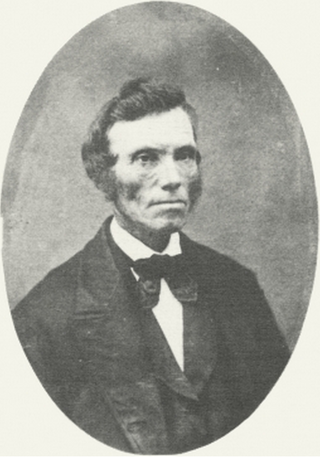
Stephen Post was an early member of the Latter Day Saint movement who became President of Sidney Rigdon's Rigdonite church after Rigdon's death in 1876.










